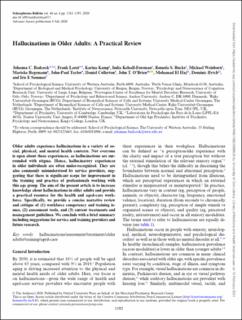Hallucinations in older adults: A practical review
Badcock, Johanna C.; Larøi, Frank; Kamp, Karina; Kelsall-Foreman, India; Bucks, Romola S.; Weinborn, Michael; Begemann, Marieke; Taylor, John-Paul; Collerton, Daniel; O'Brien, John T.; El Haj, Mohamad; Ffytche, Dominic; Sommer, Iris Else Clara
Journal article, Peer reviewed
Published version

Åpne
Permanent lenke
https://hdl.handle.net/11250/2727290Utgivelsesdato
2020Metadata
Vis full innførselSamlinger
Originalversjon
10.1093/schbul/sbaa073Sammendrag
By 2050, it is estimated that 16% of people will be aged above 65 years, compared with 9% in 2019.1 Population aging is driving increased attention to the physical and mental health needs of older adults. Here, our focus is on hallucinations—given the wide range of health and aged-care service providers who encounter people with these experiences in their workplace. Hallucinations can be defined as “a perception-like experience with the clarity and impact of a true perception but without the external stimulation of the relevant sensory organ” 2 (cf. 3–5), though this belies the difficulty in discerning the boundaries between normal and abnormal perception.6 Hallucinations need to be distinguished from illusions, which are perceptual experiences in which an external stimulus is misperceived or misinterpreted.2 In practice, hallucinations vary in content (eg, perception of people, animals, or objects), character (eg, frequency, emotional valence, location), duration (from seconds to chronically present), complexity (eg, perception of simple stimuli vs organized scenes or objects), and quality (eg, perceived reality, intrusiveness) and occur in all sensory modalities. The terms used to refer to hallucinations are equally diverse
